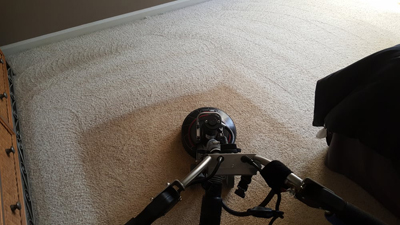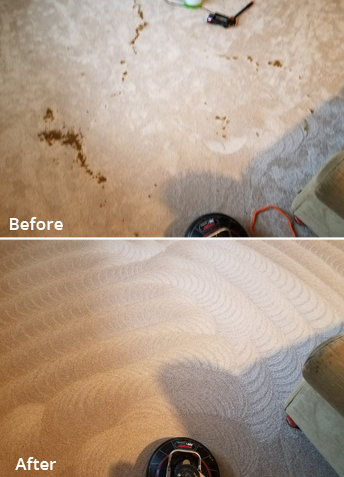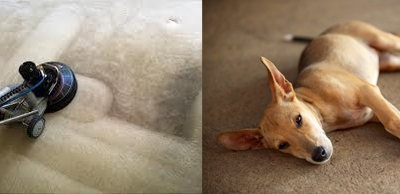Pet Cleanup and Urine Remediation
Pet urine can permanently damage your carpet. Pet stains can lead to poor air quality and create an unhealthy indoor environment. When urine is first deposited onto a floor or fabric, it has a pH of about 5 or 6, which is on the acid side of the pH Scale. It is easier to remove pet spots from the carpet right then when they are fresh. Once urine dries it turns “alkaline” or to a high pH between 10 to12 on the scale and becomes more difficult to remove. The warm acid state of the urine offers a perfect breeding ground for bacteria, which begin to flourish almost immediately. In this original acid state the urine begins to oxidize and react with the carpet to create a color change, which will become permanent if the urine is not removed immediately. Some of this color change can be attributed to the strong ammonia that forms as the urine passes through bacterial and chemical change. If left for days or weeks, depending on the fabric or floor type, it will change the dye structure, therefore causing permanent staining. Even if the soluble deposits are removed, the damage to the dye structure may already be done.
There are two sources of odors associated with urine. The first comes from bacteria that grow abundantly in dark warm places with a constant food source. This bacteria growth and breakdown of the urine creates amino acids. These complex organic compounds will often work deep into the fibers to a point of becoming part of the fiber. This presents a challenging situation. The waste materials and gases from the decomposing urine create an unpleasant odor. When dried urine is remoistened, it gives off an ammonia gas.

The second source of odor is chemical odor that is present even when the bacteria have been killed. This explains the reason that more than sanitizing is necessary to neutralize odors from urine. Urine also presents additional odor problems when the relative humidity is high. The salts and crystals that are left behind as the urine dries are hydrophilic and draw water to them. Dried urine is often easy to smell in the humid months because the salts attract the moisture, the moisture evaporates putting out a greater proportion of odorous ammonia gas. You must get rid of the urine salts in and under the carpet to get rid of the odor. That’s why cleaning existing urine spots WILL NOT remove any associated odor. In fact, it could increase the odor in the air space for a temporary period of time.
After a thorough inspection, our technicians will go over possible cleaning options and rates that will best address your needs. However, we realize that cost is a factor in decision making, so we will be happy to give you a quote for less aggressive treatment. While a lesser treatment will be less effective, it can save a lot of money. For example, someone whose pets continue to mark the carpet may decide to use a less expensive, less involved method for removing stains and odors because they will need to repeat it in the near future. These are our treatments:
- Very minor damage/spotting: enzyme treat and clean carpet with our standard cleaning process.
- Moderate damage/damage confined to a limited area: Soak the carpet and pad with a solution that will break up the deposits, then do a full extraction. Finally, clean carpet with our standard cleaning process.
- Major damage/extensive contamination: this will involve cleaning both sides of the carpet, sealing the floor, and replacing the pad and tack strips. See the full description under Major Damage, below.
Remember, in order to remove the odor, all of the alkaline salt deposits the urine leaves behind must be completely removed. This can be quite extensive and time consuming. In the worst cases, all of the following steps will be done.

- Pull up carpet.
- Remove affected pad.
- Kill fungal growth.
- Dry floor completely.
- Sand Floor.
- Clean back of carpet.
- Treat floor with an enzyme treatment.
- Seal floor with an odor barrier/fungal sealant.
- Treat back of carpet with enzyme treatment.
- Install new tack strip.
- Install new pad.
- Re-install carpet.
- Clean carpet.
- Topically apply enzyme.
Do-It-Yourself Pet Stain Removal
The best tool to have is a wet vac or small spot removal machine. If you can get the urine up while it is fresh you will have a better chance of 100% removal. Simply suck the urine right out of the carpet. Then pour a measuring cup of warm water on the spot and extract it to rinse the carpet. Always dry the carpet as much as possible and never scrub or rub the carpet. This will distort the face fiber and break down the fiber protection and allow for easy staining.

If the urine spot is older than 24 hours, mix 1 part white distilled vinegar with 2 parts water and apply it to the spot, rinse with warm water, and wet vac. You should not use the vinegar on fresh spots as the acid from the vinegar can’t counter the acid from fresh urine. The vinegar works best after 24 hours when the urine has become alkaline.
The Best Cleaning Agents for Urine
Enzymes are the best cleaning agent for urine, vomit and feces. An enzyme is the only cleaning agent that actually eats up the bad bacteria. For the best results use an enzyme spotter after you have rinsed the carpet, especially if the spot is not a fresh one. Ask me, and I will give you one when I clean your carpet. Enzymes can also be purchased at any local pet store. Don’t forget to read the directions!
Products to Avoid
Try to stay away from products with high pH such as ammonia, Resolve and oxygen bleaches. These products will leave the carpet with a residue and in a high pH state, which will enable the carpet to attract dirt like a magnet. In some instances the use of the wrong product can cause the pet stain to be permanent.
Disclaimer: Use these techniques at your own risk. Always read directions on any spotter before using. Pre-test each spotter in an inconspicuous area before using. If the stain or odor persists, call Carpet Pro Cleaners!

